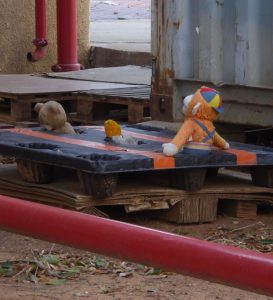
Naomi’s photos
No pictures, videos or creative games.
I needed a direct, no frills approach, to highlight my point this time.
My high school students’ final exams (internal and then national) are coming up. In between we have holidays and school trips (not to mention a slew of lectures), all cancelling lessons.
The clock is ticking.
It’s time to pick my fights – review skills most of my struggling learners have been able to employ successfully when they actually remember to keep them in mind.
What’s more, I have discovered that using the word “trap” seems to awaken a competitive streak in some of the students, so I’ve decided to capitalize on their awakened interest.

Naomi’s Photos
I told the students that whomever it is that writes the national final exams knows that some students have a system for answering multiple choice questions on reading comprehension tasks. A system that doesn’t require reading. These students simply look for words that look alike in the options and in the text and then choose their answer without further investigation. For example:
| The Sentence from the Text | The Wrong Answer |
| 1. Mr. Jay invested 11 million dollars in the football team. | X Mr. Jay earned 11 million dollars from the football team. |
Such students see the words “11 million dollars” and fall blithely into the trap the exam writer has set. They distractor that “looks-alike” is the wrong one (“Duh”, my strong students would say, but this is not for them)!
So, I challenged the students to outsmart the exam writers and not fall into the “look-alike” trap that has been set for them.
Together we examined 8 sentences, which I have modified from actual national exams (I had to modify the sentences to make them clear when being read out of context) and corresponding incorrect answers chosen by unknown students who had forgotten about the “traps”. I didn’t worry about vocabulary – I supplied any glosses needed. The students led the activity, almost all of them were able to explain why the answer chosen was incorrect. Or, to rephrase, what caused the unknown student who picked such an answer (they, of course, would never do such a thing!) to do so.
The fact that the students were able to analyze the errors successfully with hardly any guidance on my part (mainly glossing or adding context) didn’t mean the activity was too easy.
Quite the opposite.
They seemed to feel empowered. They could avoid a trap! They weren’t going to lose 8 points over nothing!
But will all of this actually come into play when the students take their national finals?
That remains to be seen…

Naomi’s Photos
Here is the worksheet I used. The downloadable document contains two versions – one with the “critical” words underlined, and the other with no hints whatsoever. I used the version without any words underlined.
***Remember – this is not a worksheet for self-study. It is the discussion that matters. I was even able to sneak in a reminder about superlatives…
What a great idea. Thanks for sharing the worksheet, I’ll try it on my students.
Glad you liked it, Jane!
Thanks!
Hi, I have been using a similar strategy with students in a special ed class doing 3 points bagrut for the composition. Suddenly they have to write 60-70 words. How do we ‘beat” the exam?
I use the AEL books and we analyze how to use the instructions of the written section of the bagrut to help give us at least an opening sentence or two if not more. I tell them we want correct English not the truth. They can write anything about themselves as long as it is correct English even if it’s not 100% true. They like that.
Thanks for the tip.
It’s so great that you understand what I mean, Deena!
Share, cooperate and support – we teachers need that!
Thanks for the idea!
Naomi
I’m a middle school EFL teacher. I teach twice a week and find myself constantly modifying lesson plans and goals in order to fit as much possible into the little time we have in the year. It is really a struggle to achieve fluency throughout the week or month or even year when we have so many cancellations during the month. I think it is important to teach the main skills and focus less on the subject itself. For Bagruyot, I suppose it’s important and very helpful to help the students identify the “traps” and tricks. I think your technique is clever in instilling a sense of confidence and “upper-hand” in the students when they approach the exam questions and tasks. With this, I believe they are developing reading comprehension skills.
Sapphire
Thank you, Saphhire!
The sense of a lack of time gets worse the closer you get to the final exam…
I’m so glad you found the post interesting!
Yours,
Naomi